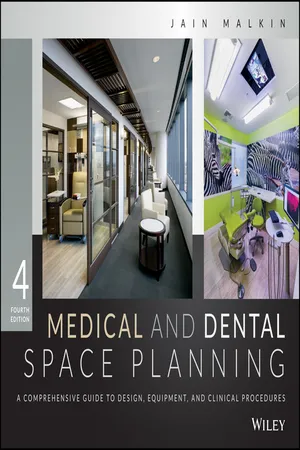
Medical and Dental Space Planning
A Comprehensive Guide to Design, Equipment, and Clinical Procedures
Jain Malkin
- English
- ePUB (apto para móviles)
- Disponible en iOS y Android
Medical and Dental Space Planning
A Comprehensive Guide to Design, Equipment, and Clinical Procedures
Jain Malkin
Información del libro
THE UPDATED DEFINITIVE REFERENCE ON MEDICAL AND DENTAL OFFICE DESIGN
Medical and Dental Space Planning is an indispensable guide to the myriad of details that make a medical or dental practice efficient and productive. The unique needs of more than thirty specialties, as well as primary care, are explained in the context of new technology and the many regulatory and compliance issues influencing design. Concepts are also presented for ambulatory surgical centers, diagnostic imaging, clinical laboratories, breast care clinics, endoscopy centers, community health centers, radiation oncology, and single-specialty and multispecialty group practices and clinics. A thorough review of the latest dental technology and many creative space plans and design ideas for each dental specialty will be of interest to both dentists and design professionals. Important topics like infection control are top of mind, influencing every aspect of dental office design.
An "inside look" at what goes on in each specialist's office will familiarize readers with medical and dental procedures, how they are executed, and the types of equipment used. Technology has radically impacted medical and dental practice: digital radiography, electronic health records, mobile health devices, point-of-care diagnostic testing, digital diagnostic instrumentation, CAD/CAM systems for digital dental impressions and milling of restorations in the dentist's office, portable handheld X-ray, and 3D cone beam computed tomography for dentists all have major implications for facility design.
The influence of the Affordable Care Act is transforming primary care from volume-based to value-based, which has an impact on the design of facilities, resulting in team collaboration spaces, larger consultative examination/assessment rooms, and accommodation for multidisciplinary practitioners who proactively manage patient care, often in a patient-centered medical home context.
The wealth of information in this book is organized to make it easy to use and practical. Program tables accompany each medical and dental specialty to help the designer compute the number and sizes of required rooms and total square footage for each practice. This handy reference can be used during interviews for a "reality check" on a client's program or during space planning. Other features, for example, help untangle the web of compliance and code issues governing office-based surgery.
Illustrated with more than 600 photographs and drawings, Medical and Dental Space Planning is an essential tool for interior designers and architects as well as dentists, physicians, and practice management consultants.